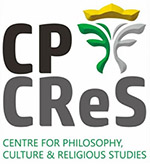Archives
-
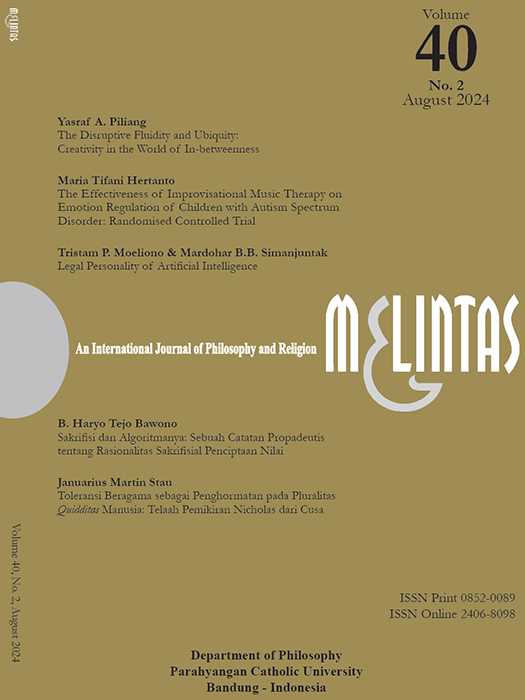
Vol. 40 No. 2 (2024)
Emancipatory thinking refers to intellectual frameworks and ideologies focused on freeing individuals or groups from diverse forms of oppression, whether social, political, economic, or cultural. Rooted in critical theory, these ideas emphasize the importance of agency, autonomy, and equality, challenging the existing structures that perpetuate inequality and marginalization. These often call for a transformation of consciousness and societal structures, empowering persons and communities to challenge the status quo and propose a reliable solution.
In this edition, we provide critical reflections that aim to deepen our understanding of key issues, potentially enriching discussions on the evolving dynamics of the world. The first article suggests a method to bridge the gap between ‘high-brow’ and ‘low-brow’ art forms and lifestyles. The author argues that bridging these extremes requires dismantling the conceptual divide between them. The article concludes that the approaches proposed by Deleuze-Guattari and Paul Virilio are well-suited to the fluidity of a non-dichotomic world marked by ubiquitous computing (UC) and the Internet of Things (IoT). The second article addresses the profound absence of self-awareness in children with autism spectrum disorder (ASD). The author explores the potential of music as a means to alleviate this disorder. The findings align with the theoretical framework proposed by Patricia Churchland concerning the role of auditory phenomena in perception building. The third article explores the overlooked issue of non-human legal subjects, specifically artificial intelligence approaching Artificial General Intelligence (AGI). As virtual and augmented reality increasingly influence human lives, ignoring their impact risks significant mistreatment, neglect and even harm. The authors conclude that traditional legal frameworks must be adapted to address the evolving “the digital living space” of the metaversal era. The fourth article seeks to re-emphasise the importance of sacrifice and sacrificial actions as central to defining one’s existence. After thoroughly examining key sources on sacrifice across various categories, the author concludes that dismissing the vital role of sacrifice based on pseudo-rationality and mere assumptions is illogical. The fifth article explores a unified understanding of humanity through Nicholas Cusa’s quidditas as a conceptual framework. Historically, religious differences have often been misinterpreted as the cause of ongoing conflicts across civilizations. By applying a rational approach grounded in the dictum uno religio in rituum varietate, the author concludes that uniqueness can serve as a foundation for interreligious dialogues, helping to bridge gaps between different faith traditions.
Historically, emancipatory ideas and actions have played a pivotal role during periods of significant change. A central issue that arises is identifying the loci of emancipation. In light of the rapidly evolving world, a reconsideration of what holds the greatest importance becomes imperative. Answers to these questions are the next logical steps for a further and more humane world to live in.
Editor.
-
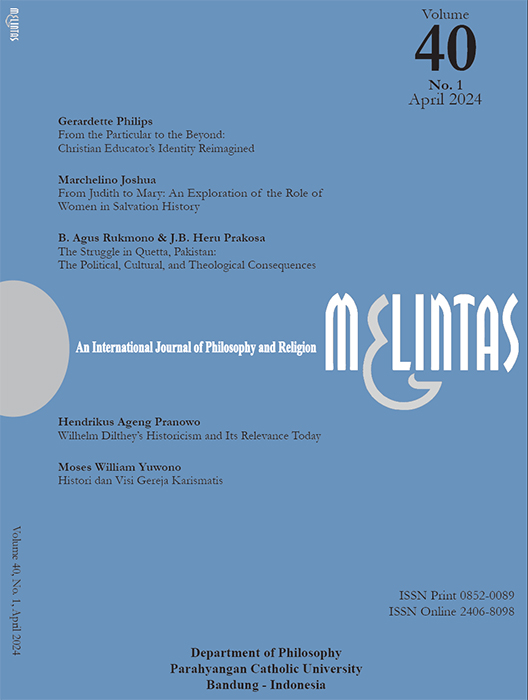
Vol. 40 No. 1 (2024)
The question of identity is always a challenging and significant discourse, impacting the lives of citizens around the world. The difficulty is not in its continuity but in evaluating how genuinely new and complex these emerging forms of identity are. As technology advances, the way humans live their daily life changes dramatically. While technological breakthroughs in the previous century unfolded over decades, today, transformations occur within years, or even months. What has already happened often far precedes and reshapes what is happening now. A retrospective view is always, in some sense, prospective. In similar manner, what identity ‘was’ is always ‘is’ and “will probably be”.
This edition of Melintas provides several propositions to five different issues. The first article emphasizes the importance of Christian storytelling methods in education as a foundation for fostering a more humane understanding in an increasingly tumultuous world with conflicting interests. The author concludes that these barriers can only be overcome through powerful stories from inspiring figures, with the Eucharistic narrative being no exception. The second article explores the biblical figure Judith and the parallels between her and Mary, the mother of Jesus. Through exegetical methods and theological reflections, the author argues that both Judith and Mary represent an active essence of femininity that transcends the patriarchal limitations traditionally assigned to women in religious narratives. The third article analyzes the ongoing ethno-religious conflicts in Quetta, a region in Pakistan. The tumultuous situations have escalated into a string of violence that claims civilian lives. The authors reveal multiple causes as the root of this conflict. In their conclusion, they suggest an interethnic and interfaith dialogue mediated by an independent organization as a promising answer to resolve the political, cultural, and religious conundrums. The fourth article traces the root of historicism coined by Wilhelm Dilthey as a blending tool of analyses constructed on Kantian and Hegelian lines of thought. The author uses Dilthey’s approach to address the overuse and overemphasis of rationality in the Western culture, especially when dealing with pluralism and multiple identities. The fifth article put the advent of charismatic movements in Christianity on the spotlight, in that it is a phenomenon that cannot be simply put aside. Not merely an alternative approach to rejuvenating the Church’s ministry, the charismatic movement emphasizing the Renewal of Christian faith through the Holy Spirit urges a progressive demand for a charismatic Church. This, according to the author, is how the new religious identity embodies its present in an ever changing society.
The words “know thyself” coined by Socrates have proven to be one of the most difficult problems to answer. Nevertheless, endless efforts to provide the best answers have always been fruitful if not impactful. From human rights to emancipatory movements around the world, it is still one of the best questions that we have.
Editor.
-
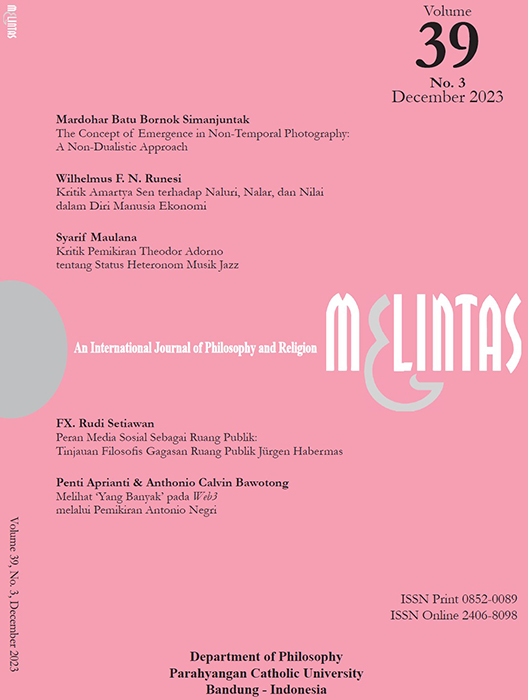
Vol. 39 No. 3 (2023)
Does time exist? Every time, humans imagine and try so hard that some certain events in their lives can be immortalised. It means longer happiness, continued prosperity, and romance that can always be enjoyed. The desire to record an event reflects the hope that life will become timeless. The parts of life that are full of suffering, on the other hand, want to be passed as quickly as possible. We are like creators of a measure called time, who then regret of what we have created, and now in vain want to erase it.
When we realise that time cannot be erased or corrected, we begin to criticise everything. There is a drive to prove that we are important in “this moment”. Maybe this awareness is better than remaining silent and resigned in front of a ‘mistake’ of creating the category of time. This edition of Melintas observes things in our time. The first article sees the problem of temporality in photography, that has invoked a continuous debate concerning the artistic nature of this medium. Previously taken as a different way of seeing, the time signature in a photograph became debatable along with the development of digital photography. The author concludes that the advancement of photography lies in its potential to pursue non-duality interactions. The second article observes how problems such as poverty, hunger, injustice and social inequality have not been resolved because policy makers are still trapped in the prison of strong desires. The author offers an interpretation and analysis of Amartya Sen’s thoughts regarding how reason should stem the urge to lust. Every policy will be correct if it has undergone critical rational testing. The third article seeks to pinpoint Adorno’s fallacies in his critique of jazz music, based on his failure to formulate the ontological aspects of jazz music which rigidly adhere to canonical forms, his inability to situate the potential of jazz music within autonomous art, and the distortions stemming from stereotypes about jazz music prevalent in his time. The fourth article is an analysis of social media and its potential role as a public space, using Habermas’ theoretical framework. Social media still has a big influence on democracy and social change. The author recommends that social media users need to have and to develop their social media literacy based on the principles of solidarity, criticality, and caution. The fifth article delves into how Web3 or Web 3.0 shows the tension between dominant currents and resistance to global multinational power systems. In this context, the authors use Antonio Negri’s perspective in Empire and Multitude to investigate the complex dynamics that occur, and situate the development of the internet within a more inclusive and equitable realm.
Sometimes we need to be critical of time. So far, time has been taken for granted to determine everything, including objectivity and rationality. Pausing in silence to analyse situations and experiences is a way to ‘stop’ time. We might not enter eternity, but we enter the essence of experience, a very real experience.
Editor.
-
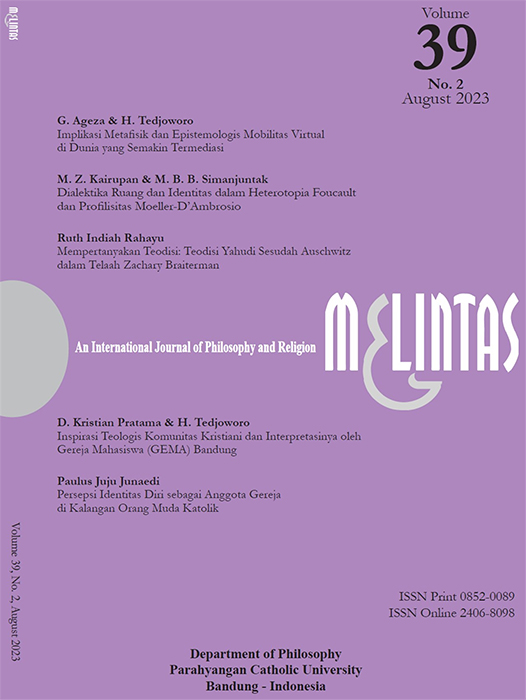
Vol. 39 No. 2 (2023)
Self-perception is in the image. Conversing about the breadth or the narrowness of self-perception and the perception of a community will go beyond mere formulations. There are times when we have to ask other people what they see in us. Others are always able to provide a more honest image of ourselves. Self-perception, therefore, is not seen in a mirror, but is ‘heard’ from the impressions of others. In the past, perception was often valued lower than interpretation. Now that assessment is questionable.
Let us try to capture other people's views. Their perceptions are our perceptions, whether we like them or not. We never capture our own images honestly, therefore we learn to capture others’ views of us. This edition of Melintas sees what others see in us. The first article elaborates the metaphysical and epistemological implications of virtual mobility in a world increasingly mediated by ‘screens’, which give rise to several different perspectives that question the Carthusian and dualistic conceptual framework of reality. Perhaps it is not the literal or symbolic screen that must be reinterpreted, but the human perspective itself. The second article sees the interplay between space and the construction of identity and elucidates the elements and aspects of both space and identity. It draws upon Michel Foucault’s concept of heterotopia for the understanding of space and the theory of profile formulated by Hans-Georg Moeller and Paul J. D’Ambrosio. The third article discusses how contemporary Jewish theologians, rabbis, and philosophers have revisited their theodicy by critically reading scriptural texts and traditions. It sees the problem of Jewish theodicy after Auschwitz as studied by Zachary Braiterman by explaining the split between the hegemony of Jewish theodicy with a religious discourse and anti-theodicy with a pagan discourse. The fourth article traces the development of ideas about Christian community in the Scriptures, in the views of the Church fathers, theologians, and in the Church documents. The theological inspirations are correlated with the interpretations of the moderator priests of Student Church (Gema) and with the experiences of the Catholic students in the city of Bandung. The fifth article explores the self-perception of young Catholics as members of the Catholic Church amidst the diversity of the ecclesiastical communities. The author observes the ways of carrying out the Catholic learning by conducting a research among the young Catholics in Bandung concerning their perceptions of being members of the Catholic Church.
Self-perception, more than just a subjective view, is a treasure that we obtain from the views of other people. Thinkers may create their own theories regarding the self-image or the image of a community, but we will find a more honest image as long as we still relate and listen to others.
Editor.
-
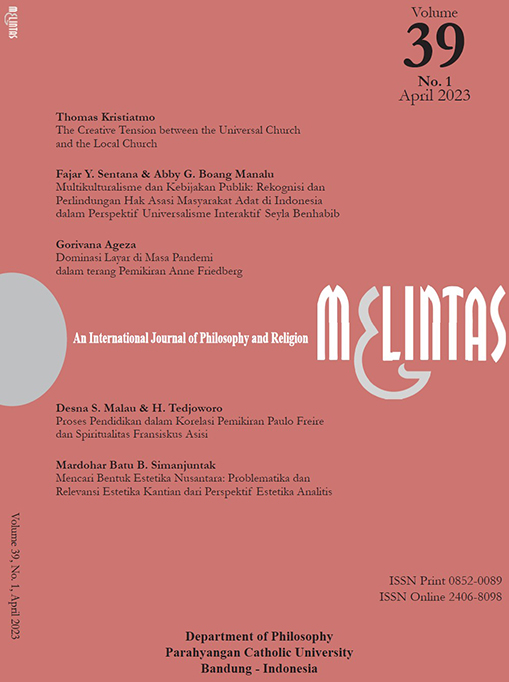
Vol. 39 No. 1 (2023)
Identity tends to be lived in everyday life, and is not truly examined or questioned. Some people think that they already know who they are, and almost never trace when their identity was first seen clearly. In fact, can identity be defined? Defining identity is a matter of who a person wants to be, but discovering and seeing identity is a different matter that is not just (re)defining it. Identity becomes important when there is an ‘other’. At that moment we find out our identity because of that ‘other’. We do not define our identity, since it goes far beyond simply our desires. That is why the matter of who we are grows in relationship with others. We are ‘defined’ by a form of togetherness that has always been intrinsic to reality.
As individuals or as a group, we develop our identity in the relationships with others. We change and grow. This time Melintas will explore how and because of what circumstances our view of ourselves develops and is enriched by the (re)connections with others. Some ideas and perspectives might change who we are. The first article examines the creative tension between the universal Church and the local church. History has witnessed that sometimes there were tensions between the two and the solutions offered are oftentimes one-sided. The article deals with the tension by using creativity to explore new ways of constructing local theologies. The second article discusses the issue of recognition and protection of indigenous peoples’ rights in Indonesia in the light of Seyla Benhabib's interactive universalism. It analyses the challenges and opportunities by emphasising cultural diversity and the importance of the local context.. The third article sees how ‘screen’ allows humans to experience and understand the world without being limited by the existence of their physical body in the light of Anne Friedberg’s thoughts. It analyses the consequences of the massive virtual mobility and screen dominance since the outbreak of the Covid-19 pandemic. The fourth article explores how Paulo Freire’s philosophical thinking and the spirituality of Francis of Assisi can inspire the world of education, particularly in Indonesia. The philosophical concept of education is used as a rational framework for evaluating the educational process, and the spiritual inspiration provides a common vision to direct and enrich the atmosphere of education. The fifth article tries to find a common philosophical grounding for an Indonesian aesthetics by elaborating Immanuel Kant’s arguments. It takes an initiative to seek theoretical framework inspired by Kant’s implied position of the sublime for the artistic practices in the modern Indonesia.
The question of ‘who’ is linked to the countless complex layers in an everyday web of interrelationships. We always need others to discover who we are in the midst of this singular universe. Instead of imagining a fantastic yet confusing multiverse, it would be much more realistic if we pursued our role in the togetherness of all humanity in this beautiful world, right now.
Editor.
-
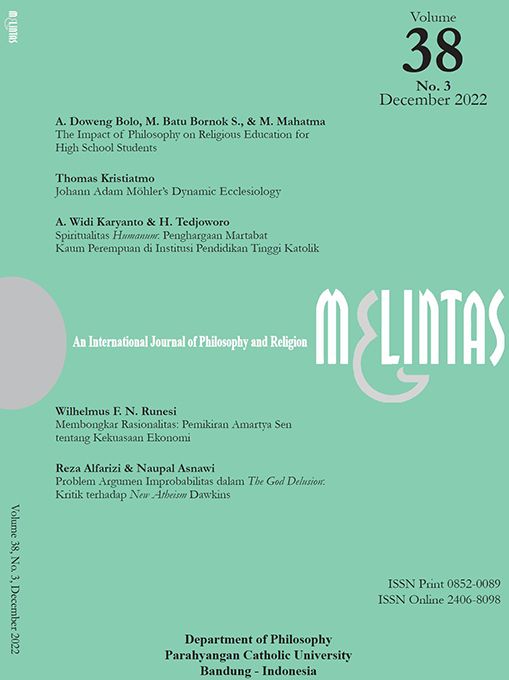
Vol. 38 No. 3 (2022)
Rationality is like food that we swallow without realising whether it is delicious or even beneficial for us. Reading an academic journal automatically places our views and thoughts in a rigid rational framework. Is it true that rationality is overly presupposed in the academic world? The direct consequence is that irrational things are eliminated from our conversations. It is ironic that every day life is stripped of the very things that make it alive. The academic world seems to have to learn to be irrational in order to be more alive.
Let us reveal everything behind reasonable matters. Furthermore, let the texts question our ways of thinking and viewing. This edition of Melintas might bring us to a different path of academic journey. The first article examines the interrelation between religion and philosophy and measures how such interaction is embodied in religious subjects taught in middle-high schools in Indonesia. Three important characteristics are analysed, viz., the breadth of perspective about God, the openness towards other religions, and the willingness to embrace science in general. The second article sees how Möhler’s ecclesiology is influenced by romanticism without being too abstract. His ecclesiology is exemplary of a creative ecclesiology that can manage various tensions due to different ways of understanding the nature of the Church. The third article proposes a spirituality of humanum practised in a Catholic university as a framework for higher education to respect the dignity of women and men involved in the institution, so that all individuals in the campus are accepted as noble images of God. The fourth article tries to reveal the fallacy of rationality behind the policies used to implement power, which are promulgated by the government regarding economics in order to overcome various social and humanitarian problems such as poverty, hunger, and injustice in the society. The fifth article demonstrates the philosophical problems in Dawkins’ improbability argument, which reduces reality (ontology) based on subjective perception (epistemology), and thus obscuring the uniqueness of natural phenomenon and negating the existence of God. Alternative ethical perspectives regarding religion and God are proposed to address Dawkins’ accusations to religion as a source of evil and violence.
We may find that an academic journey is more of a continuous metanoia than simply satisfying the desire to think rationally. At the moment we want to eat food, first pay attention to whether we really want or need to eat it. Argument is food for our knowledge, and the strength of any argument lies in its openness to further refinement.
Editor.
-

Vol. 38 No. 2 (2022)
Where do culture and morality come from? From a person or from a community? When we realise that humans create culture, we may come to the discovery that a person, a community, and the world cannot be discussed individually. Talking about a person involves the power of imagination in making present the community where the person lives as well as the other communities that make up this world as a whole. A person is a community. A community is a person. Morality is an inseparable part of the wholeness of a person, and the wholeness of the community, and the wholeness of the world. The issue here may not be about who created what, but about what makes a person a person.
Our community is enriched by cultures. Our being persons is an interaction of cultures that brings forward salient values orienting our everydayness. This edition of Melintas brings insights to deepen our reflections on being in this world. The first article affirms the Catholic view that human life must be respected and given the basic rights to live as human person since the conception. The author analyses the difference between the medical experts and the Catholic Church, which results from the different perspectives on the time of the beginning of a human person. The second article sees Teilhard de Chardin’s writings on Christology compared to other theologians’ writings, and explains why Teilhard sees the evolution as a process with a definite purpose to the Omega point. The third article brings together religion in Hegel’s philosophy and the cultural belief of the Lembata people called Lera-Wulan Tana-Ekan. Belief in the universe, the highest morality, and the origin of creation are analysed in relation to Hegel‘s Spirit in natural religion, religion of art, and revealed religion. The fourth article observes the role of Biantara and Paparikan of the Sundanese culture in the ritual of engagement in the Catholic Church. This practice of inculturation is proposed to reconsider the viewpoints of the faithful, the need for further development, and the possible modifications that might be required in the local church context. The fifth article proposes practical recommendations for religious and priests to refresh their interpretations of their respective spirituality in order to proclaim the Gospel to the ever-connected people of this digital age.
We live in a world that connects and nurtures us to experience the fullness of existence with others. We cannot live without the nature, and therefore the values we believe in should sustain the existence of all creation. More than looking for differences to argue about, let us find the dots that connect our beings. Those dots are much more priceless than our individual perspectives.
Editor.
-
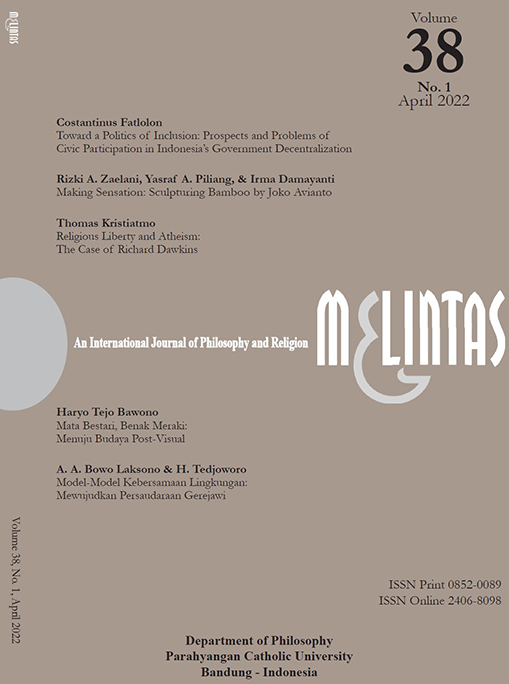
Vol. 38 No. 1 (2022)
Not everyone is willing to stop for a moment. Stopping is considered counterproductive. When someone stops thinking, thoughts are lost. No creativity and no movement. But that might be true when stopping means doing nothing. Stopping, looked at differently, is actually moving. Our mind is reflecting and imagining in a way we do not understand normally. Perhaps in the state of stopping we are not really frozen, but are in the state of an extreem slowness. Reason can stop functioning. Our mind, on the other hand, cannot, as long as we are alive. Stopping remains as a real moment that will happen anytime, even when our self does not want to stop.
Now we can stop with whatever we are doing if, and only if living ideas still matter to us. This edition of Melintas brings various areas into a moment of reflection. The first article assesses the shortcomings and possibilities of deepening civic participation in Indonesia’s government decentralization. The local people must be educated and capacitated to maximise the benefits of government decentralization, while civil society groups step in to practice democratic principles in civic participation and lawmaking. The second article sees Joko Avianto’s three-dimensional works exhibited in Frankfurt, Germany, and Yokohama, Japan, as examples of Deleuze-Guattari’s explanation of monuments of sensations in their embodiment. Art is special because of its capability to both transcend and surpass the limits to rediscover or restore the boundless. The third article, through the Second Vatican Council document Dignitatis Humanae, sees religious liberty in the face of atheism, which in this article is focused on atheism as promoted by Richard Dawkins. The fourth article observes how in today’s cinematic society or visual and digital culture, the boundaries or bridges between the eye and the mind are becoming increasingly blurred. It invites the readers to an awareness of the trend towards the fading boundaries, and simultaneously deals with the dangers of unawareness. The fifth article addresses the issue of the Catholics’ decrease of participation in the parochial lingkungan by offering some models of togetherness, inspired by the Scriptures and the Church documents such as Evangelii Gaudium and Fratelli Tutti. These can be fresh alternatives for realising ecclesial communion among the faithful.
Stopping other activities gives us time to reflect on the tiny moment of now. People might think that we are doing nothing, but that does not really matter compared to the reflections surfacing in our mind. The mind is moving and alive not only because of the great ideas, but also because of the deep reflections that awaken our existence.
-
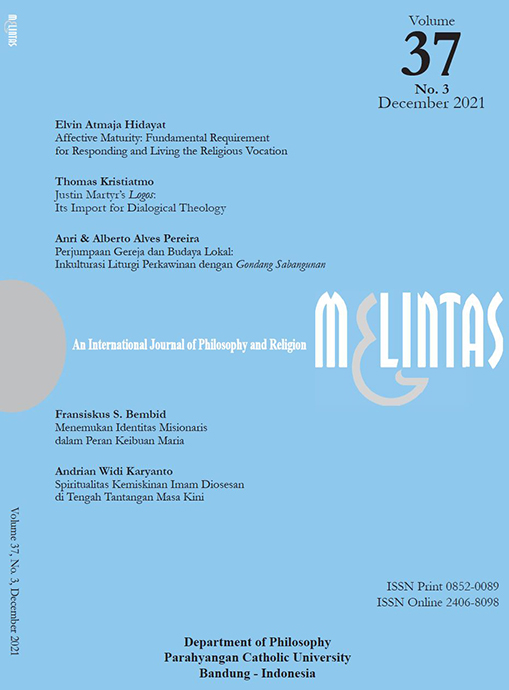
Vol. 37 No. 3 (2021)
Meanings surface wherever human minds interact. Discussions and conversations help new meanings exist. Perhaps words and events that keep intermingling in everydayness will redefine our intention in seeking meanings. Do we create the latter, or do we continue to live by them? Someone seems to have lost the intention to live because it becomes hard to find life as meaningful. Knowing ourselves has been an adage that holds our mind sound and alive, but now it is even getting harder to be convinced that life is indeed meaningful. The border between meaningfulness and meaninglessness is blurring at the same time when the intention to live seems more and more dependent on the surfacing of meanings.
Knowing oneself goes back to the matter of identity. Instead of understood as articulating or verbalising about who we are, it probably is an interaction of how the other sees us in the various events and encounters. This edition of Melintas walks through the history of spirituality and identity in Christianity. The first article attempts to describe one of the aspects of human maturity, namely the “affective (emotional) maturity”, in relation to the choice of celibacy as a religious person. The significance of human affectivity lies in its correlation with other aspects of maturity, and affective maturity becomes a measuring tool as well as a fundamental requirement in the religious vocation. The second article sees Justin Martyr’s Logos and its import for a dialogical theology. Justin’s idea of logos spermatikos, developed to cross and connect the then seemingly unbridgeable systems—Greek philosophy and Christianity—proves to be valuable for contemporary theologians in doing theology of dialog today. The third article explores the inculturation of marriage liturgy with the music of gondang sabangunan Batak Toba, particularly in the Roman Catholic rite. This inculturation can be seen as an encounter of Christ, the Church, and the local culture, and the process might bring the faithful, especially the Batak Toba people, towards the experiences of repentance, holiness, and salvation. The fourth article finds the spiritual-theological meanings of the role of Mary in conceiving and giving birth to Jesus Christ in line with the identity of a missionary. It brings some ecclesiological implications, in face of the growing spiritual individualism and competition tendency in the life of faith. The fifth article reflects on the spirituality of poverty in the vocational life of diocesan priests and how it can strengthen their identity in face of the challenges in the world today. It sees a different perspective of this spirituality, even when its is not considered as a requirement in the formation process of a diocesan priest.
Reading through the articles might bring us to a realisation that meanings keep us alive. Spirituality can be considered a journey of seeking meanings that will shape our identity. Perhaps we will never finish this journey in life, but we are glad to know that we are not doing this alone, for identities interact.
-

Vol. 37 No. 2 (2021)
‘Salvation’ might have been translated into various terms by different fields of study. For some it means the condition of being alive and well, for others it can be related to survival, harmony, the prime of life, completeness, metanoia, faithfulness, et cetera. Whatever we imagine and think about being saved, there are always a lot of interpretations according to the lived world of each individual. In this horizon, the question “Have you been saved?” might just be identical to the question “Are you okay?”. One does not have to have philosophical or theological background to answer this sort of question. It completely depends on how you live your life in this very moment.
However, as long as we live, our mind is constantly changing its perspective in seeing our salvation on this earth. This edition of Melintas pools the interpretations of how we walk the different journeys towards salvation. The first article sees the impact of the so-called “Damascus Event” on Saint Paul, an event that moves him from ‘christification’ to a mission of salvation. Paul’s christification brings direct implications to his courage in becoming a follower of Christ with a burning passion to proclaim the Gospel to all nations. The second article follows Pope Francis’ idea of an integral ecology in Laudato Si’ and Leonardo Boff’s idea of eco-spirituality to propose a different perspective to save the cosmos in crisis. The author explores how human spiritual crisis should be encountered with a worldview that emphasises on the unity of all components that exist in the cosmos as God’s creation. The third article presents a different reading of Arthur Schopenhauer’s metaphysics by finding consistencies between his understanding of will and thing-in-itself. It explains that the true function of the will in his metaphysics lies in the name and concept by which one can think about thing-in-itself objectively. The fourth article sees that the unit of transmission and replication in the cultural evolution can be associated with meme. Its author explores how memes are spread out through human interactions and the various kinds of media, and therefore culture will always be in the state of developing and changing. The fifth article elucidates human being’s tendency towards goodness in the perspective of Thomas Aquinas. This goodness appears externally in the human action, and as an external action it is named actus humanus, which manifests the moral aspect of a human being.
Back again to the question of salvation, we cannot simply express our interpretations about the state of being saved or of being okay. Salvation is a matter of our experience in the lived world. Interpretations always come later. For the sake of discourse and understanding, interpretations can enrich the process of discovering meanings. But our mind in everydayness finds the meaningfulness of life in how we live in each moment. Stay saved.
-
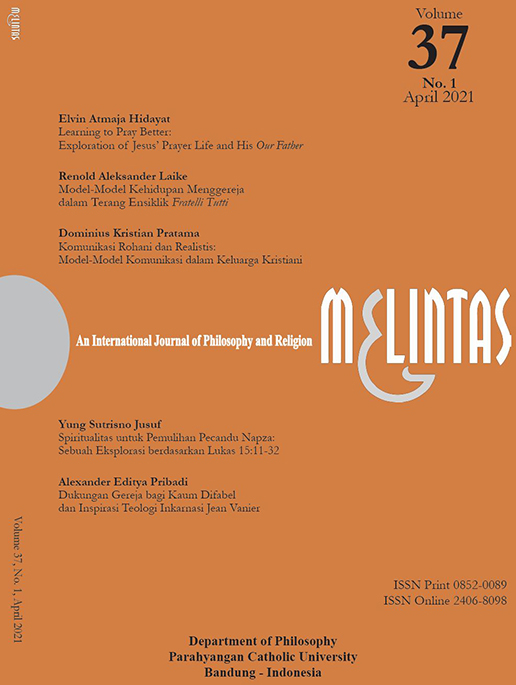
Vol. 37 No. 1 (2021)
Theology and spirituality. When understanding leads to action, we are moving together with the world. When reason touches our senses, we begin to know the reality we experience. Knowing might not so much a stage of the reason as a gesture of the living self. It is also in this sense that knowing theologically should bring us back spiritually to the world of experience. There is nothing wrong with moving between the fields of theology and spirituality, for these are correlated ways of being in the world. Differences and contradictions, as well as dephts and superficialities, are mere perspectives reconcilled in conversations. And what life will look like without conversations? Spirituality brings awareness of “the other”, while theology makes sense of the ideas emerging from the encounters.
This edition of Melintas stands between these perspectives. In the dialogue of theology with the experienced realities, spiritualities surface. The articles in this edition mirror different gestures of how the authors live the dynamics of reasoning. The first article spiritually explores how Jesus teaches the disciples to pray from a practical point of view. With the prayer “Our Father”, Jesus teaches how to pray properly and correctly from particular aspects, one of which is to whom one should pray and what things one should ask for in prayer. The second article offers some models to (re)build the fraternity in the Church by delving into the spirituality inspired by Pope Francis’ Fratelli Tutti. The models bring forward particular themes like generosity without borders, all-embracing dialogue, and new encounters. The third article delves into everyday spirituality of communication among the members of Christian families. Its author proposes three models, i.e., realistic, spiritual, and imaginative communication models that may inspire families to practice communication in the light of Christian spirituality. The fourth article explores the Prodigal Son parable in Luke 15:11-32 to inspire a model of spirituality that can be used in a rehabilitation community for drug addicts, namely, the spirituality of compassion and mercy. In this spirituality, a drug addict is readmitted to the community to restore his or her dignity. The fifth article sees how the Church can support people with different abilities through its roles and services in the society. The author uses Jean Vanier’s theology of incarnation to inspire solidarity among all people who are different but created equally good by God.
Spirituality can broaden our academic horizons in doing theology. Real-world points of view are inevitable, especially when we are moving between fields and participating in everyday conversations with others. Perhaps an unveiling in our experiences is more of a discovery of the given layers rather than a construction of new ideas. Spirituality is a reality.
-
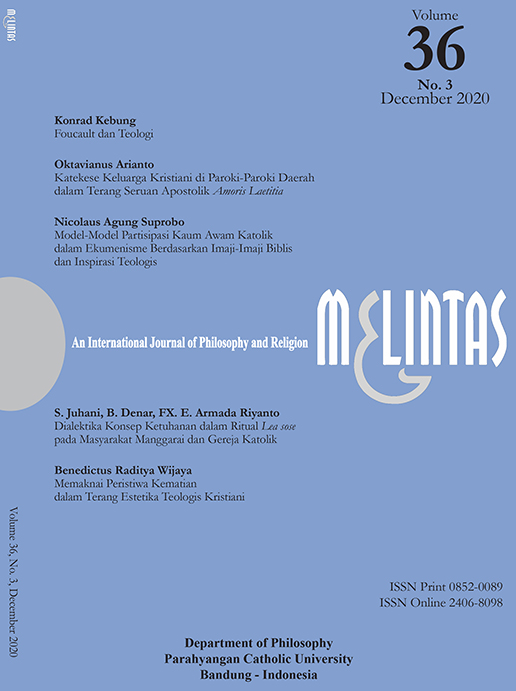
Vol. 36 No. 3 (2020)
The word ‘theology’ seems to have provoked various reactions, ranging from inattention to suspicion. In the academy, that same word has often been forced to fit within the category of religion and is associated with unscientific matters and worse, irrational thoughts. Perhaps these are part of the consequences of seeing reason as the only way to understand reality. However, we can continue arguing about the term ‘understanding’ as well. Is theology about understanding? Or, is it about way of being (with) and of living (with)? Sometimes it is that with that creates a huge difference on our perspective. Regardless of our believe or not believe in God, theology is unavoidable as long as there is “the other” in our reality.
The articles in this edition of Melintas bring up various aspects of human relatedness with God philosophically and theologically. The first article presents the relation between Michel Foucault’s philosophical thoughts and theology, following the tendency that recently many poststructuralists and postmodern thinkers have been interested in this issue. One can find in his thoughts raw materials useful for theological reflections which are basically grounded on reality and the concrete life of humankind. The second article explores the roles of family members, the themes for catechesis, and the methods of Christian family catechesis to be used in rural area in Indonesia. Contextual catechesis is here referred to as a form of catechesis that takes into account the experiences of the faithful as a source of family catechesis in relation to the Scripture. The third article offers models of participation in ecumenism for the Catholic laity. Five models offered in this article are of faith conversation, friendship, sharing of spiritual wealth, dialogue of life, and familial visits. The fourth article aims to dialogue the concept of divinity in Manggarai, Indonesia, with the teachings of the Catholic Church. The approaches used by the authors of this article to trace the concept of divinity in the two contexts are mainly qualitative with ethnographic as well as documentation methods. The fifth article offers an interpretation that death is not seen as merely ‘death’ from the human perspective, but a passage towards a mystical and aesthetic point of view, which illustrates a sign of God’s calling to humans to enter the beauty and union with God.
Thinking about and living with “the other” through different areas of thought may enlarge as well as overlap our horizons, in a constructive way. Theology is not so much about absolutising religious doctrines as limitlessly correlating us with others and the Other as long as we live on this earth. Being rational does not have to mean being home alone. It is an ‘interstanding’.
H. Tedjoworo (Editor)
-
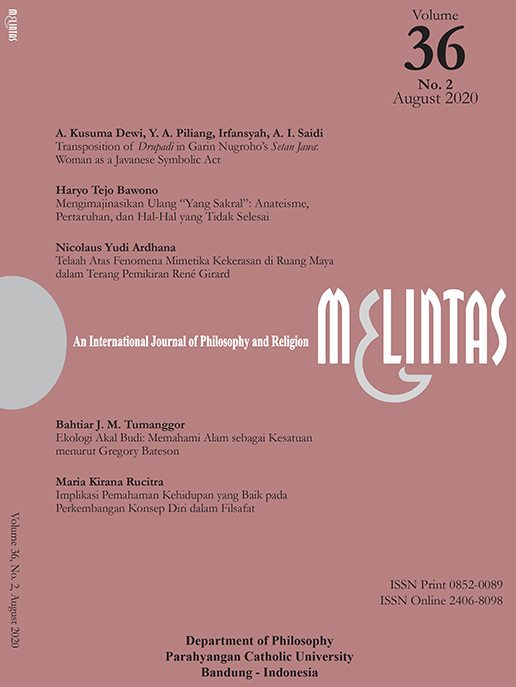
Vol. 36 No. 2 (2020)
Grammar and order place us on track. Methods keep our discussions progress on each respective framework. What about layers? Two-dimensional map might be enough for some people to live their daily reasoning activities. However, layers of reality have been ‘there’ all the time, if only one is willing to shift his or her vantage point. Not everyone really cares for it. It is truly remarkable that all these layers are given, regardless of our responsiveness to them. When or if we are aware of their reality, veering from one layer to another is a challenge we might not want to miss. It is us who create grammar and order. While chaos is not always the case if those conditions are not met, layers of reality can bring mind-opening voyage.
We can veer from one layer to another layer of phenomena. This edition of Melintas offers some journeys through the perceptions. The first article uses textual analysis to identify the transformative adaptation of a character in Javanese wayang cultural narrative in Garin Nugroho’s Setan Jawa film. The author sees a different representation of the character to the conventions in the Javanese culture. The second article reimagines “the sacred” in the light of Richard Kearney’s anatheism related to the concepts of wager and unfinished matters. Humans do not need to separate the sacred from the so-called sensus numinis, because their lives, bodies, minds, and actions are esentially sacred. The third article sees humans’ naturally mimetic character on violence in the internet and cyberspace in the light of René Girard’s theories. Its author attempts to offer some alternatives to respond to the situation of violence in the cyberspace and the internet, by promoting humans’ critical and creative role as “positive imitator”. The fourth article asks our attention to the ecology crisis resulting from the speeding of human civilisation with its sudden jumps on science and technology. It offers Gregory Bateson’s epistemological ideas to offer systemic paradigm that can be used to sense nature as oneness of system leading to the concept of sacrality of the earth. The fifth article attempts to unfold the problems around human being’s ‘center’ and their implications to the concept of self. The centered self understood in the light of Aristotle and Kant holds a possibility of ignoring historical and cultural values which play the pivotal parts of a human being’s constitution. The decentered self understood in the light of Richard Rorty tends to impact the clarity of the self’s path along with its purposes.
We never know what is beneath and above our often two-dimensional outlook, for our mind might have worked through the layers of the reality. We need to keep grammar, order, and methods in our line of reasoning, but an opening to the parallel tracks of perception will not hurt our commitment to the academic discussions.
H. Tedjoworo (Editor)
-
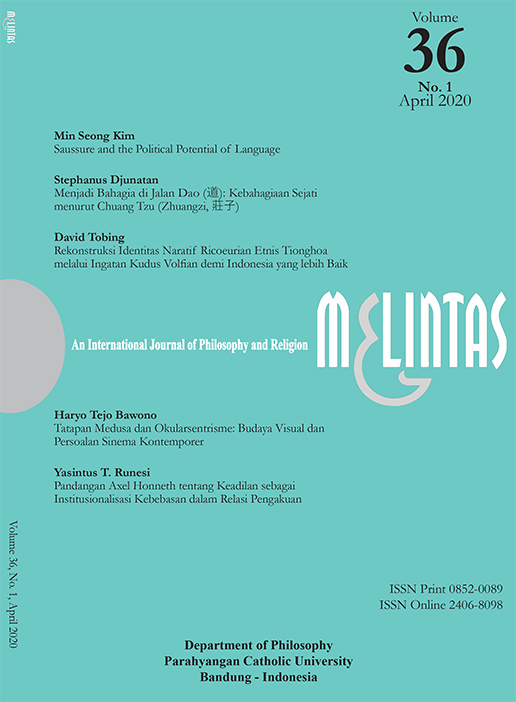
Vol. 36 No. 1 (2020)
Image is language. Language is image. Today identities are characterised by the universe of images and words. Plurality turns into madness of things in reality that often cannot be perceived sanely anymore. How would Aristotle respond to all this? Back to particularity? Or, back to the Anima? It is tongue-in-cheek that everyone seems to satisfy his or her own narcissism by way of expressing thoughts, while the Anima imagined by Aristotle might refer to a humanity consisting of identities rather than to myriad of created personalities.
Our efforts in expressing ideas sometimes complicate life matters like never before. However, it is always our own choice to read or not to read. This edition of Melintas leaves the choice to the reader’s imagination. We do not have to read, as long as some insights have been keeping us alive. The first article offers a reconstruction of the social and political dimensions that were present within Ferdinand de Saussure’s theorisation. The article explores the historical development of the concept of discourse to unearth the political potential of language. The second article explores the thoughts of Chuang Tzu (ca. 369-286 BC), who elaborates cognitive and intuitive sides of human mind and offers a philosophy in order to bring forward an awareness of reality as itself. The article shows the conjunctions of cognitive and intuitive capabilities of human mind, as well as its rational and mystical sides. The third article offers a way to reconstruct a Ricoeurian narrative identity as the form and a Volfian sacred memory as the content, in order to transform the Chinesse narrative identity in Indonesia from a victim or a wounded self into a survivor or a healing self. The fourth article invites the readers to be aware of the negative inclinations around the issues of image and ocularcentrism in the contemporary visual culture, and offers some philosophical interpretations towards the conception of a ‘moving’ image. The fifth article explores Axel Honneth’s normative reconstruction of social liberty as discussed in his book, Freedom’s Right, and offers the idea of justice as institutionalised freedom that may enlarge the individuals’ horizon of solidarity as future citizens. These articles dwell into the particularities of images and language that shape our identity within the reality.
In sensing the reality we live in, we might want to reimagine ourselves as a singular Aristotelian Anima of humanity that is always moving with and interconnected to the universe. We do not want to let our rational thoughts complicate the simplicity of our identity and the givenness of Being.
Editor.
-
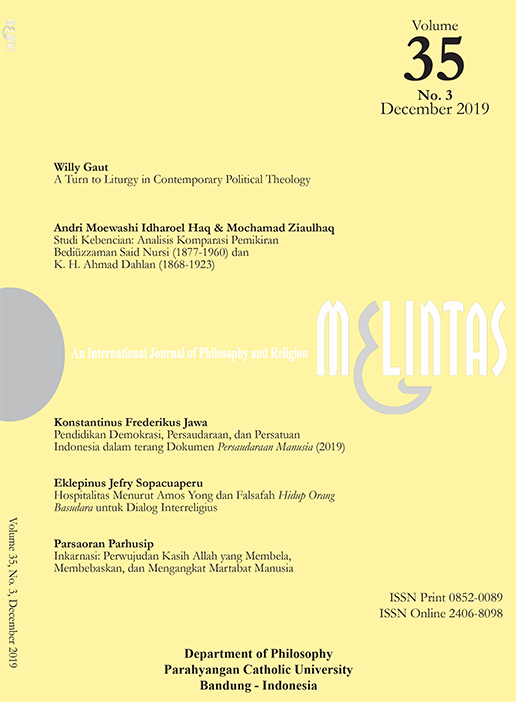
Vol. 35 No. 3 (2019)
Democracy and religion seem to find it hard to make friends. But who knows? Sometimes politics and theology are about perspective. When reflected on from a particular perspective, public policies and doctrines might shake each other’s hand. We know that a term as strong as ‘belief’ can be catastrophic in discussion, but yet is often taken for granted without further realisation. It might depend on what really matters in our life: to win a debate or to live together happily. It is not an oversimplification, since, again, it is a matter of perspective.
Writings are perspectives that require our engagement with particular texts. We do not have to agree to the ideas, but we can see from different viewpoints. This edition of Melintas brings forward some themes in theology, politics, interreligious dialogue, and human dignity. The first article shows the turn to liturgy in contemporary Christian political theology. The political nature of the Church and its political role wells up from its identity as the sign and instrument of the Kingdom of God, and as such, in its political engagement, the Church is not considered merely as a social or voluntary organisation. The second article does a comparison of thoughts and movements of two Islamic figures who are significant in ‘Muhammadiyah’, namely, Bediüzzaman Said Nursi (1877-1960) in Turkey and K. H. Ahmad Dahlan (1686-1923) in Indonesia. It shows how hatred was transformed into nonviolent practices by these figures. The third article sees democracy education, fraternity, and unity in Indonesia in the light of the “Document on Human Fraternity for World Peace and Living Together” (2019), signed by Pope Francis and Sheikh Ahmed el-Tayeb. The fourth article explores hospitality according to Amos Yong as the basic character needed in developing interreligious dialogues. The author discerns the local wisdom phrased as Hidup Orang Basudara as a characteristic of hospitality that can be used to develop interreligious dialogue in Molucca, Indonesia. The fifth article reflects on Christian incarnation as an event of manifestation of God’s love in defending, liberating, and elevating human dignity. This event of incarnation brings the image of the Church as God’s people who are liberated while still in pilgrimage on earth. The authors of these articles invite us to see from different perspectives in order to able to live together as human beings and to share our views.
Others’ views are enriching and liberating. By sharing our different views, we are not so much contrasting ideas and debating beliefs as building a liveable place to meet each other as guests. Everyone is a guest in this world of shared perspectives.
Editor.
-
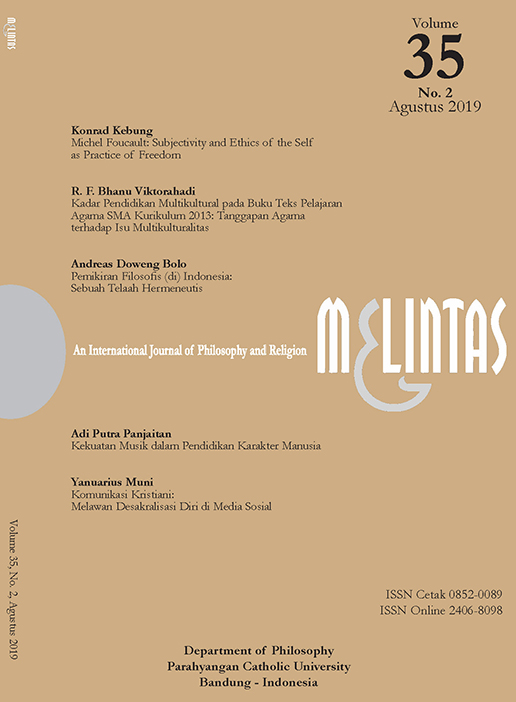
Vol. 35 No. 2 (2019)
Our senses are amazing. Yet, there have been tendencies to underrate them. We know that it is from our senses that we build the concept of sensitivity. The latter, as a concept, however, has shifted from the realness of day-to-day experiences of the self to the domain of ideas. Can our ways of doing philosophy or doing theology be sensible – that these are real to our senses? A thorny question, indeed. It needs no answer, except our journey towards different destinations.
Being sensible can bring difference in our writings. We put our full attention on the subject matter we are exploring, whilst letting our senses perceive movements and changes. In this edition of Melintas we will find authors who reflect on topics that are closely related to human self, sensitivity, and experience. The first author presents the thoughts of Michel Foucault, who brilliantly analyses the historical events of the past as creative criticisms for shaping human attitudes today, and shows his readers various practices of the self through meditation and inner examination, as well as the practice of telling the truth (parrhesia) to oneself and to others. The second author analyses degrees of integration of plurality and multiculturality values in the curricula of Islamic Religious Education and Catholic Religious Education in high schools in Indonesia, in order to explore students’ possible contribution in promoting the values in the society. The third author correlates experiences, theories, and possibilities concerning the emergence of philosophical thoughts in Indonesia from a hermeneutical viewpoint, and sees how the thoughts build up from the real situations lived by ordinary people responding to the challenges in their lives. The fourth author explores the power of music through its particular elements, which includes melody, rhythm, harmony, beat, dynamics, timbre, and lyrics, in relation to human character education. The fifth author explores the elements of Christian communication based on the Church teachings on the subject matter, in order to counter the tendency of desacralisation of the self on social media and to promote truthful as well as deliberating communication in the society. These authors contribute insights from different perspectives on the interrelatedness of experience and idea.
What we sense in experience turns into something completely different when reflected on in our mind and written in words. Perhaps this image of a passage can elucidate the movement of our sensitivity. Still, human senses are amazing.
Editor.
-
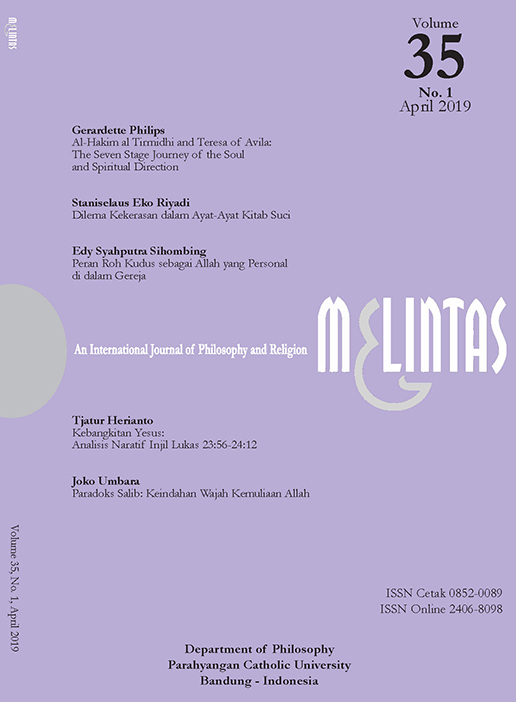
Vol. 35 No. 1 (2019)
Why spirituality? Human beings as reflected in their knowledge are a multilayered reality. We cannot ignore some layers of our reality simply because we do not (want to) understand them. When reality is seen as a thing in itself, science as well as philosophy and theology might detach themselves and become ‘neutral’, which, in a sense, are not personal or related to human beings anymore. Spirituality takes everything personal, since each person is related to the reality in ways undreamed-of. There is always a perhaps in our being connected personally to reality.
Our business with this kind of ‘perhaps’ extends towards texts on spirituality and eventually the Scriptures. This edition of Melintas will explore how human beings relate themselves personally to God. The first article explores the theories and insights of the spiritual stage theory from Islam through Sufism using the psychology of Al-Hakim al Tirmidhi and Christianity through Teresa of Avila, and the spiritual direction best suited for spiritual directees at different stages. The second article suggests that violence in the Christian biblical texts must be understood within the context of defining religious identity of a nation among the other nations that have their own gods. Violence in the biblical texts cannot be referred to as a sort of justification for any violent acts by religions in our multireligious and multiethnic society. The third article contemplates the aspects of human personal experience of the Holy Spirit in relation to the theological language of the Persons in Trinity, so that the Christians may discern the presence of the Holy Spirit in their lives. It sees the need of ‘translating’ theological language into comprehensible language of catechism. The fourth article examines the resurrection narrative of Jesus Christ in Luke 23:56-24:12 by revealing its narrative elements and offering day-to-day inspirations that might be beneficial to the Christians. The fifth article contemplates the cross of Jesus Christ in its paradox and how in the light of Balthasar’s theology the cross is seen as the revealing beauty of God’s glory in Christ’s loving gesture towards humanity and the world. From these articles, some layers of our relation to reality emerge not as usual business, but as a spirituality that cannot be unnoticed. Spirituality is always personal.
We need to reconsider the tendency of being ‘neutral’ in philosophising and theologising. In that way, we might forfeit the richness of our personal relations to reality and a deeper knowledge of the self in the presence of The Other.
Editor.
-
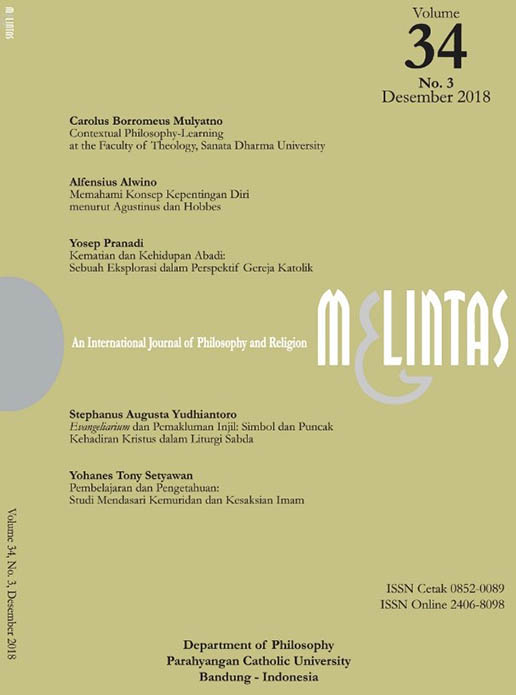
Vol. 34 No. 3 (2018)
We are learning seriously about things that matter to us. For not everything matters, and human beings will not learn about anything. Our humanity leads us towards some purposes that can be seen only by each of us, and this path brings enjoyment. It is remarkable to see how children can learn so much by playing, as if there is no other way of learning. It might be hilarious as well, if only we, adults, can see learning and playing as two sides of the same coin. An interplay between our experience and our knowledge was once associated with the so-called reflexive learning – a serious ‘game’ of mind, if you like.
The business of learning about our being human in the world can lead to further moral and theological reflections. In this edition of Melintas we will find some authors who are seeing reasons and purposes that have moved different people towards different paths of life. The first author sees how philosophy-learning is an integral part of the educational formation at the Faculty of Theology, Sanata Dharma University, Yogyakarta, Indonesia. It is integrated with theology and other sciences-learning to shape the identity of the faculty and to contribute to the development of the community. The second author shifts the focus from the study of knowledge to the study of human self-interest according to St. Augustine and Thomas Hobbes. While Augustine believes that self-interest is a dark act rooted in self-love and must be subjugated to the absolute God, Hobbes sees that the natural state of human beings is in war with each other and harmony can be established by a sovereign ruler. The third author reflects on death and eternal life theologically in face of the fact that most Christians still find it hard to accept death as part of their life. The article attempts to explore some biblical, philosophical, and theological perspectives on the subject matters. The fourth author explores part of the Eucharist in relation to the priest’s role in the Catholic ritual and explains how Christ's presence in the Liturgy of the Word is marked symbolically with the book of Evangeliary and with the act of proclaiming the Gospel. The fifth author reflects on the intellectual formation of priest candidates in the Catholic Church and how studying philosophy, theology, and humanities underlies the call towards discipleship and witness.
Learning about our humanity and our purpose in life can be done on different paths, but it should bring delight and playfulness. We need not exaggerate our approach in learning, for we only see something seriously when it matters to us. In fact, we should enjoy our knowledge. Hope you know how.
Editor.
-

Vol. 34 No. 2 (2018)
Being a nation is more than a matter of identity, let alone a matter of religion. We do not introduce ourselves to others starting with a nationality. But belonging to a nation shapes our images of who we are and of our personhood. We might be learning things about ourselves precisely when telling others about who we are in what we are doing at the moment. Then comes the emotion. People smile. We are happy and settled when connected to the differences surrounding us. Everyone needs a place.
This edition of Melintas brings philosophical and theological reflections on finding ourselves through community, dialogue, politics, science, and art. The first article shows how Christian communities can develop themselves into ‘counter-communities’. This article is aimed at discovering the relevance of the idea ‘counter-communities’ to the problems of coexistence of different religious followers in the Post-New-Order era in Indonesia. The second article introduces the views of Carlo Maria Martini, who, as a Catholic bishop, has promoted the idea of creating a society that supports diversity to be a new world order. The author relates them to Anthony Giddens and Raimon Panikkar, and finds how Martini’s ideas can be practised not only by inclusivists and pluralists, but also by exclusivists. The third article portrays the dynamics of democracy in Indonesia, both in its formal settings and as a building that allows humanity reach its dignity. Pancasila Democracy can be a space for a change towards Indonesia that is more animating to the spirit of divinity, humanity, and nationalism and towards a society with solid physical and spiritual well-being. The fourth article sees how the spirit of modernism to question and to break down nature, religion, and tradition under the pretext of pragmatic utopia of growth has brought humanity into an alarming phase. It refers to Fritjof Capra when saying that that the main problem of the existential crisis of modern humans is caused by the crisis of perception, mainly with the influence and errors from science as well as from Cartesian and Newtonian thoughts in perceiving the reality mechanically. The fifth article refers to Sartre when offering a notion of analogon, that has a key role to explain his concept of imagination. The author goes further in explaining Sartre’s concept of irreality in artworks, of which analogon is a medium or a material vehicle. A person’s imagination plays an important role in his or her presence before an artwork.
Will we find our place? At any given moment. Otherwise, there will be no reflection anymore in our imagination to play with. It is not wrong to be grateful of our nation. It has been our place to live. Thank God we can find some happiness in realising who we are.
Editor.
-
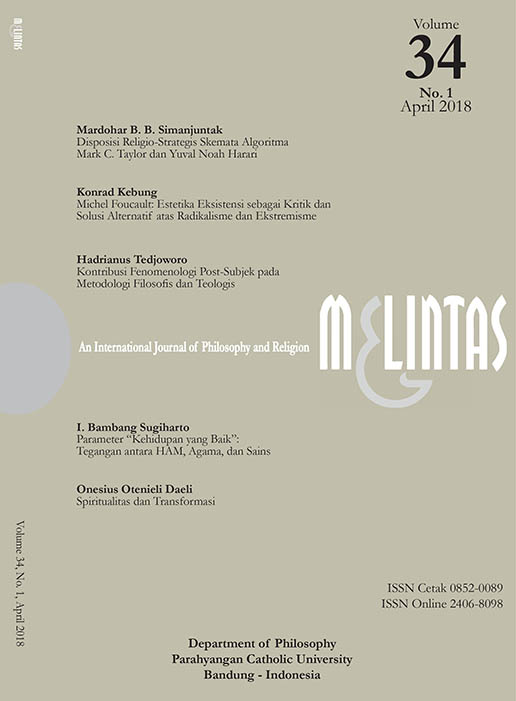
Vol. 34 No. 1 (2018)
When changes dominate our reality, there are people who are still petrified of them. Being frightened of change could be compared to being afraid of the reality itself. We have a very long philosophical history of the self and even this very moment is not its conclusion. Why should change be frightening? So much for the ideal formulation of the self that just brings us more and more distant from our ‘self’. Some might sense that this awareness is more aristotelian in character, but we could say that changes are the reality and reality is actual in changes. There is no sense in judging any change in our society.
The realness of life we live by day after day might not so much change us as teach us who we are. This edition of Melintas brings us different perspectives. The first article brings the question of how the self – central to epistemological inquiries – be justified by the presence of consciousness. Constructing answers to this colossal undertaking of religious identity invites a thorough understanding of how human beings can be taken as conscious. The second article presents Foucault’s philosophical thinking on the constitution of the self as the peak point of all his works from his early writings through his last writings, lectures, and seminars. To Foucault, this particular “self” should be seen as a result of a work of art that is ordered and engraved creatively and continuously. The third article discusses how Jean-Luc Marion pushes phenomenology to its limits, to the extent that he is suspected of undermining the role of the subject in contemporary philosophical discourse. However, Marion is quite consistent with his phenomenology, namely in offering a way out for the subject to be a witness. The author seeks insights for the benefit of philosophical and theological methodologies. The fourth article sees how the Declaration of Human Rights is universal in character – hence they can become a point of convergence among different religions – but is also susceptible to political manipulation, and subject to criticism from particular religious perspectives as well as from scientific outlook. Meanwhile, atheist scientists come up with a point of view which they claim to be more neutral and objective as far as it concerns the ideal of ‘good life’. The fifth article talks about spirituality that transforms human beings. It is not only associated with humans’ internal desires, but also something that leads them to use, develop, and optimize various other materials and cultures that could be treasured around them. Spirituality is a power to create a better life – an identity in action.
The self changes. Reality is change. These perspectives are indispensable in our life in this world. Even if we are still unsure in accepting our ‘self’ or the reality itself, we could just shift a bit from where we stand. Yes, shift.
Editor.
-
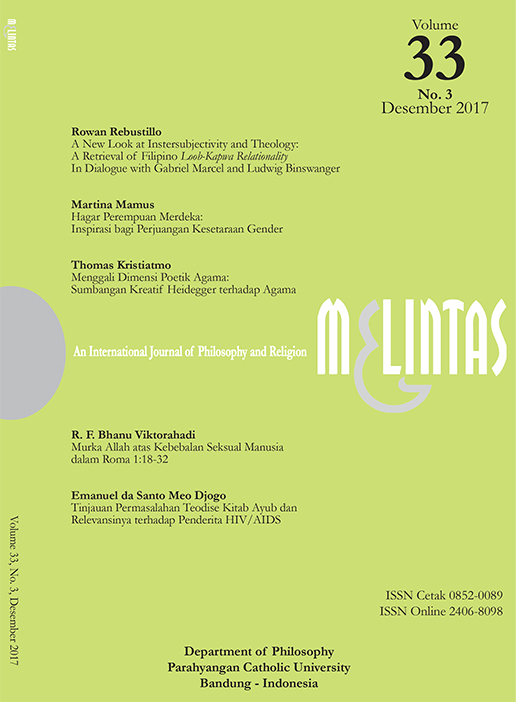
Vol. 33 No. 3 (2017)
The world is not about thought, since we see, smell, hear, and touch metaphorically. Analogy has been our way of living and relating, and in that way we are always part of the breathing reality. We move through the mystery of what we easily label experience. Do we know anything about it? Or, do we think that we know anything about it? This sort of mystery simply embarrasses us to the point that we would say to everybody that we do not want to be a theologian. We want to be left alone with our own thoughts of everything we experience in this world – these thoughts give us lonesomeness. And reality continues to breath around us.
This edition of Melintas presents theological reflections on human experiences. The first article attempts to explore some areas of convergences and divergences between Gabriel Marcel and Ludwig Binswanger, in dialogue with the Filipino concept of loob-kapwa, which the author believes provides a hospitable home for the intersubjective relation. The second article takes Hagar, a biblical figure, as a model of a woman who overcomes violence and oppression in her life – a model for many women struggling to defend their rights and dignities and believing in God who saves and frees them. Hagar never gives up amid the many difficulties she is facing as a single parent. The third article brings Heidegger’s ideas and insights to reveal the poetical dimension of religion in our contemporary world, in which religion is facing various criticisms on the violence it ironically provokes. The fourth article discusses the wrath of God towards human sexual asininity (pathe atimias) based on Paul’s letter to Rome 1:18-32. The text quotes Paul as explaining that idolatry is the result of erroneous relationship between human and God mirrored in aberrant sexuality. The fifth article speaks of the phenomenon of suffering especially in the Book of Job. The issues of human unresolved suffering, sin, and the mystery of God are brought together and related to the situation of the HIV/AIDS victims to recommend the appropriate disposition and approaches.
We want to reconnect with our experiences and to do it theologically as well, because our everydayness in the world does not always ‘make sense’. At times we simply have no idea (thought), and we need to go through the mysteries and to figure out what to do along the way. What if experience is religious?
Editor.
-
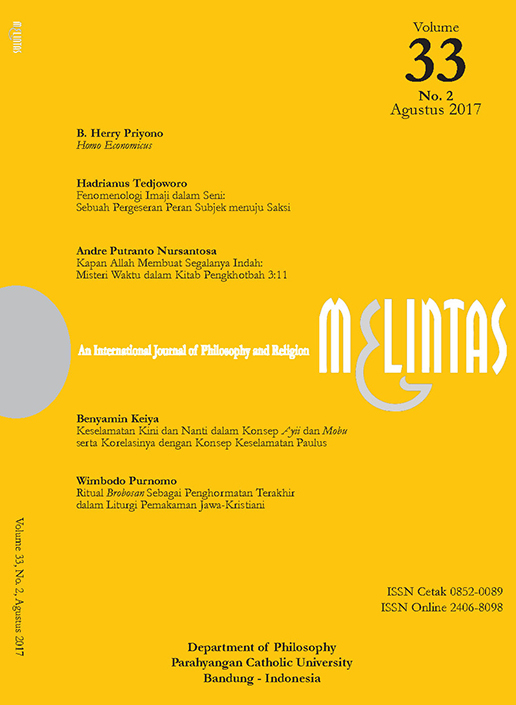
Vol. 33 No. 2 (2017)
So many illusions. But that is just a thought. And as long as we think, things might not appear as they are. From the outset of everyone’s eagerness to think, there has been this instinct to distinguish this term from that term. We simply cannot perceive anything in this world, for when trying to tell others about our experience of it, we fall back into the trap of terminology. We cannot live with others without communicating, and thus the distinguishing mind is justifiable. We need not frown upon these terms, however exhausted our mind is in using them, for these are worth the time we spend to live our mind.
Something inside us pushes the mind to reflect upon the meanings conveyed through conversations. Melintas gives way to it. This edition cultivates reflection and distinction, as well as contemplation and action. The first article reflects upon the idea of homo economicus, which was originally a particular point of view about humans but later turned into a claim about the whole of human nature. The author argues that it is not the economic beings that gave birth to economics, but the economics that created economic beings. The second article shifts the focus from concept to image. Phenomenologically speaking, art is a sort of lectio imaginem, an experience of reading and not merely interpreting the image. Each artwork is transcendent, as it were, since every time it will speak differently to a person when reencountered. The third article contemplates time biblically, especially when people think that there is good time and there is bad time. The author argues with the help of the Book of Ecclesiastes, that God has made every thing beautiful in its time, and that each point of time is theologically beautiful. The fourth article discusses the concepts of salvation according to the Ekagii people in Papua, Indonesia. The author correlates these concepts with that of Saint Paul, especially in his escathology. Paul’s tension between the terms ‘already’ and ‘not yet’ is different, but in some sense similar to the cultural concepts of the Ekagii people. The fifth article speaks about how some culturally meaningful rituals can be integrated into the liturgy. The author shows how the Javanese funeral ritual of brobosan could be seen as a pastoral means to foster the faith of the believers and at the same time to evangelise the gospel. The funeral is seen as an entrance for inculturation, bringing Christian liturgy towards the local culture and vice versa.
Our minds distinguish terms and meanings. Even if what appears to our perception is the so-called illusion, we need it as well. This tension in our way of experiencing reality and communicating our ideas keeps the conversations alive. Our minds are alive. In reality.
Editor.
-
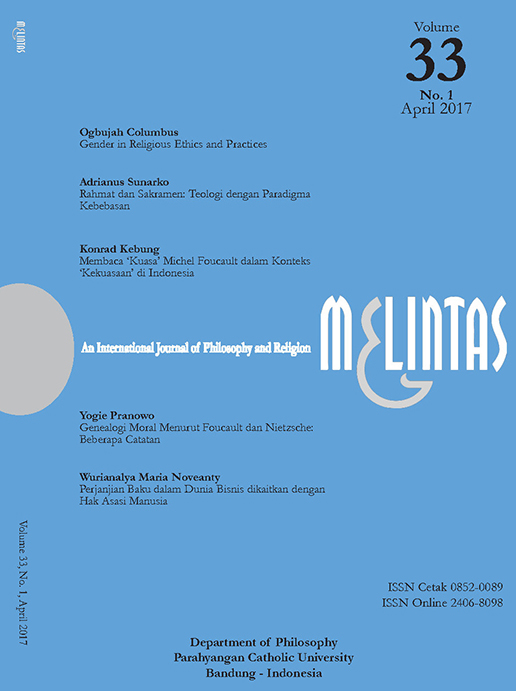
Vol. 33 No. 1 (2017)
Salvation. Is it a term for theologians or philosophers? Everyone wants to be saved. But from what? When it comes down to the ‘what’ which we want to be saved from, we do not think about the lens anymore to look at the term. Being human is the reason. Thus any discipline can and in fact must talk about how our humanity can be saved. Whatever profession we are doing right now is an opportunity to walk with the others towards the saving of humanity from anything in the world, or even within ourselves, that degrades it.
That is probably one of the causes of why ethics could be tough for some people. This edition of Melintas thinks about our being human together. We cannot exist happily in an isolated room of our appartment. The first article reflects on gender in religious ethics and practices. The author wants to unearth the insidious force of gender in the assignment of roles ‘skewed’ to favour men over women, and to highlight the underlying influence of gender on the various ethics and practices of Judaism, Christianity and Islam. The second article explores a theology with ‘freedom’ paradigm that understands grace as God and God’s actions in relationship with and insofar as humans experience them. The author explains how grace is conveyed through the celebration of the sacraments, in which the faithful experience that God is present and salvation is realised in real symbols. The third article presents Foucault’s notion on power as practiced throughout the history of the systems of thought, how this can be read into in any political power, and how his thought can be seen as criticism of various repressive powers practiced in Indonesia. The fourth article explores some similarities and differences between Foucault’s understandings and Nietzsche’s understandings of the genealogy of morals. The author argues that with reference to these thinkers one at least can be alert to whatever appears convincing so as to recognise the motive of power behind it. The fifth article sees an inequality of positions between the parties in the so-called “standard agreement” of business activities, and the fact that effectivity and efficiency are highly considered in business that human rights are often ignored. The author argues that since this kind of agreement is still needed by the society, there is a requirement to apply the principle of justice in formulating the agreement.
There are always covert motives in our being together as humans. Ethics, politics, theology, and philosophy should help us save humanity, because otherwise academicians are like individuals living isolated in their own appartment and minding their own business or salvation. We are not very much plural in matters of being human.
Editor.
-
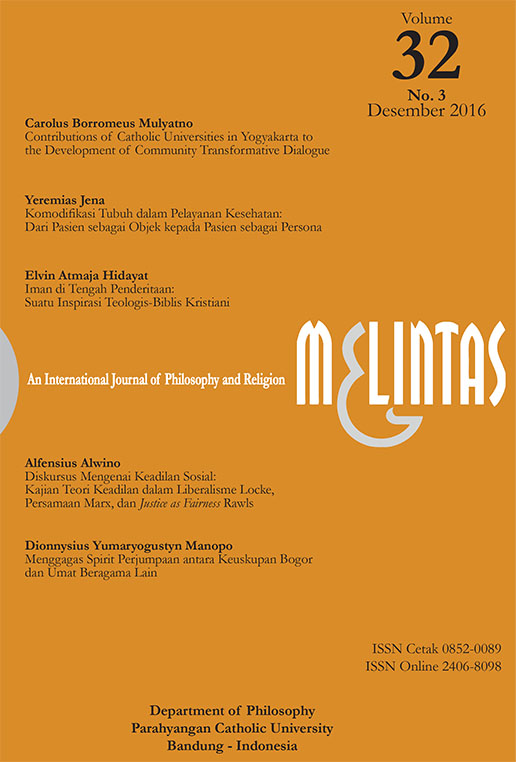
Vol. 32 No. 3 (2016)
If only a dialogue really transforms the interlocutors, differences will be a copiousness. Problem is, it often remains a dispute. No one knows the hidden discourse inside every other self. When practised through the everydayness, dialogue always conceals some motives and goals. It is almost impossible to be truthful in the so-called sharing of everything, even if this ‘everything’ has been visible and changeless. But maybe that change is the real horror behind every dialogue! Truth be told, no one wants to change. ‘Transformation’ is perhaps only for the spokespersons. The more people seek changes, the greater the fear that things might get even worse.
But we can discuss about dialogue. In conversing about this theme, we will soon be confronted with our being self and the different, sometimes contrasting, selves of other people. Melintas wants to explore our relations with the community, the body, the suffering, justice, and other religions. The first writing seeks the opportunities to realise the task of the Catholic universities in developing dialogue and harmony in Yogyakarta, Indonesia. The author suggests a model of community transformative dialogue as a contextual and cultural dialogue that could be effective and appropriate for the multicultural and multireligious societies. The second writing observes the tendency of the commodification of the body in health services that views human body as an economical commodity and causes alienating experiences. In the light of Edmund D. Pellegrino and Alfred I. Tauber, the author highlights the importance of the apprehension towards the patient as ‘persona’ in response to the tendency. The third article sheds light on the problem of suffering using the Scriptures and Catholic theology to find the different meanings behind it. The concept of God as ‘Loving Father’ is offered to help suffering people grow in their faith as God’s children. The fourth article sees the problems around the theme of justice by criticising Lockean liberalism and Marxian socialism, and in turn proposing John Rawls’s “justice as fairness” as a fresh start to build a better society. The author also finds correlations of Rawls’s theory and the philosophy of Pancasila in Indonesia. The fifth writing interprets the formulation of the vision and the mission of the Diocese of Bogor, West Java, Indonesia, particularly in shaping the relationship of the Catholics with people of other religions. The author sees some opportunities in the diocese to establish dialogue in the light of a “spirit of encounter” in order to live the image of the church as a church of relation.
We do not know when change happens, or if it happens at all. Realities change, but we, humans, seem to always find ways not to change. When fear gets in the way, every act of sharing is contested with the very motive of our presence in front of the others. Still, there is much about peace that brings more likeable change. We need to intuit.
Editor.
-
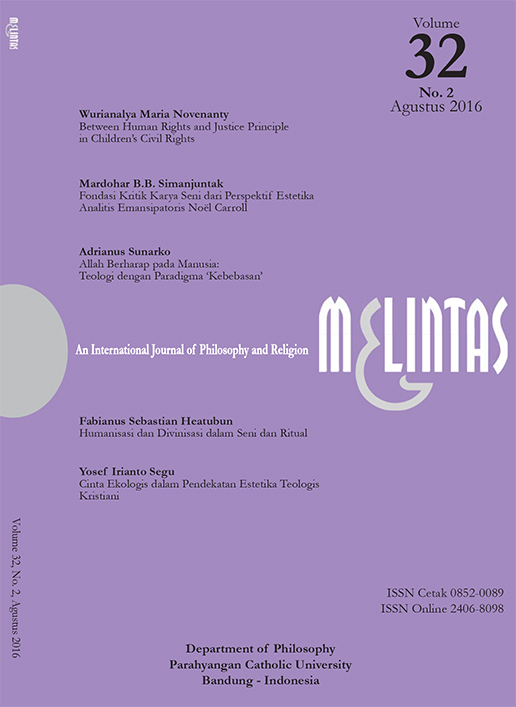
Vol. 32 No. 2 (2016)
Art does not choose. Humans do. When the freedom to be is conversed, we know that some balances in our thoughts and images are shaken. As art fills the gaps of our life graciously, being anything should not be a problem for anyone living in this same earth. Art relates humans in ways that our rational judgment cannot fully clarify or justify, for relationship might be our only chance to preserve our humanity. That is why, when isolating instead of relating, every artistic work would fall into a nonbeing. We need not judge any existence. We simply respect creatures and things we do not choose to live with. Perhaps nature chooses?
If only choosing is not something we ‘have to’ do, being related could be a good alternative for our way of being. This edition of Melintas provokes our imagination in human rights, aesthetics, theology, and ecology. The first article observes some problems in Indonesia concerning children’s civil rights, and particularly in relation to legitimate and illegitimate children. The author will discuss children’s civil rights based on civil law, human rights, and justice principle in Indonesia. The second article explores Noël Carroll’s emancipatory analytical aesthetics to approach the works of art epistemologically. It offers Caroll’s revision on Kantian aesthetic experience and Levinsonian historical definition of art towards a “historical narrative” of artwork and its criticism. The third article sees how a way of theologising by way of a ‘freedom’ paradigm can conform the requirement of reason to borderlessly question the fundamental cause of everything. ‘Freedom’ paradigm brings the potential to be the reference in understanding and formulating Christian fundamental doctrines on many themes. The fourth article looks at how ritual and art are inseparable, and that both are the hermeneutical site of meanings and values that simultaneously become the same place to find answers and to restore humanity. Ritual and art are considered central through the processes of humanisation and divinisation. The fifth article explores Christian ecological love as a crucial response to the escalating problems of human-nature relationship, from the aesthetic-theological approach. The author sees love as the self’s involvement to participate in the life of the other, that is, through the real and constructive encounters of human and nature that preserve the beautiful existence of both.
We do not choose our being human nor judge other’s being in the world, but we all are related aesthetically and naturally. Conversing about our being related to any other might bring about the awareness of being chosen as a human being. And in this knowledge, we will not be judged by those related to us, except let live in the freedom.
Editor.
